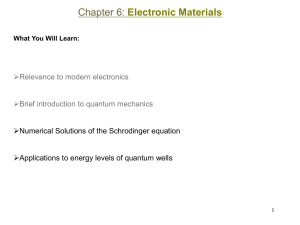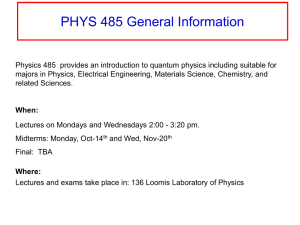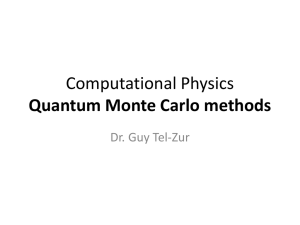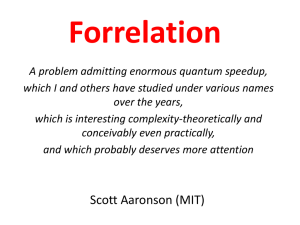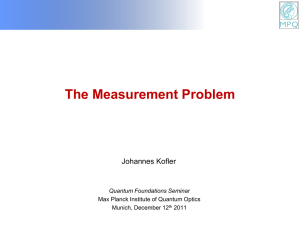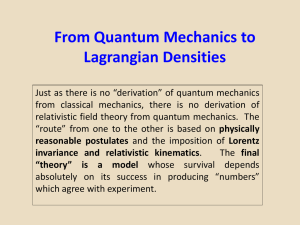collapses - Marc Madou
advertisement
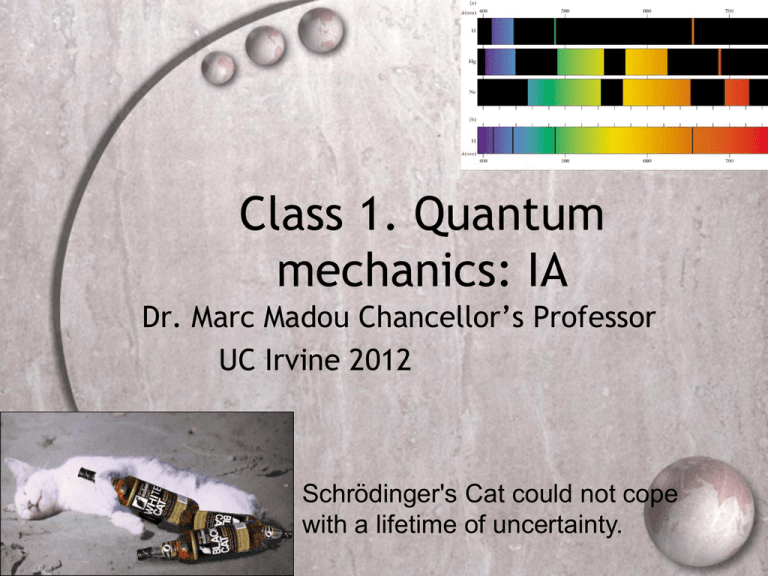
Class 1. Quantum mechanics: IA Dr. Marc Madou Chancellor’s Professor UC Irvine 2012 Schrödinger's Cat could not cope with a lifetime of uncertainty. In the IC and NEMS world, we are moving fast into the realm of quantum mechanics. Moore’s law might remain valid until about 2020 but by then the scale of electronic components will be at the molecular/atomic level, and hence can no longer be described by classical mechanics. Quantum computing, nanotechnology, including nanotubes, nanowires, biological nanostructures and quantum dots, all require some grounding in quantum mechanics to be understood at all. Quantum mechanics must now become a familiar tool not only to physicists but also to materials scientists, biologists and electrical, mechanical and bioengineers. Contents Classical Theory Starts Faltering Quantum Mechanics to the Rescue Schrödinger’s Equation Classical Theory Starts Faltering Electrical conductivity Heat capacity in metals and insulators Temperature dependence of electrical conductivity and heat capacity Hall effect Blackbody radiation Photoelectric effect Paul Drude (1863-1906). Classical Theory Starts Faltering Modern condensed matter physics really started with the discovery of the electron by J.J. Thompson in 1897. Drude describes electrons in a metal as a free electron gas (FEG) to explain electrical conductivity and Ohm’s law with: me ne2 Classical Theory Starts Faltering Using the lattice constant, a, for the mean free path, and the Maxwell-Boltzmann-Equation at T=300K to calculate vth, values for the resistivity of a metal are obtained that are six times too large. Temperature dependence is wrong too. Expected was a √T but what we get experimentally is: 0 T 1 mevth me 8kBT 2 2 ne ne a me Classical Theory Starts Faltering Since solids contain a number of atoms and electrons with similar density, why the large conductivity differences? More intriguing yet, based on the above why would carbon allotropes come with such highly varying electrical conductivities? Classical Theory Starts Based on the Drude assumption that Faltering electrons in a metal behave as a monoatomic gas of N classical particles, they Atoms in a lattice usually have no translational energy and as should be able to take up a translational temperature increases only vibrational kinetic energy when the metal is heated energy increases. According to the equipartition principle In the case of a monovalent metal, the of energy in a gas there is an internal lattice specific heat contribution, C energy U =1/2kBT per degree of freedom v,lat, equals 3R. The vibration of a So the electron contribution to the classical 1-D harmonic oscillator is U=kT –with 1/2 kT for kinetic and specific heat capacity (expressed per 1/2kT for potential energy . mole) is: From the latter we expect C v,lat to be U 3N 3 3 constant at 3R or 25 J/mol K -the so k BT = NAk BT = RT called DuLong-Petit law. n 2n 2 2 U 3 Cv,el ( )v R T n 2 Classical Theory Starts Faltering to be constant at 3R or 25 We expect Cv,lat J/mol K ( DuLong-Petit law). Experimentally, Cv, the sum of vibrational and electronic contributions (Cv= Cv,el+Cv,lat= 4.5 R), is proportional to T3 at low T and approaches a constant 3R, at high T. The total Cv for metals is found to be only slightly higher than that for insulators, which only feature lattice contributions. Where is the electronic contribution? The absence of a measurable contribution by electrons to the CV was historically one of the major objections to the classical free electron model. Conduction electrons only contribute a small part of the heat capacity of metals but they are almost entirely responsible for the electrical conductivity. Classical Theory Starts Faltering In 1853, long before Drude’s time, Gustav Wiedermann and Rudolf Franz found the ratio of thermal and electrical conductivities of all metals has almost the same value at a given temperature or one obtains Lorenz number L as: 2 c v,elmv dx 3 k B 2 ( ) =L 2 T 3ne 2 e This was obtained by: 3 1 3 cv,el nkB and mv2dx k BT 2 2 2 Lorenz number L in 10-8 Watt ohm/K2 Metal 273K 373K Ag 2.31 2.37 Au 2.35 2.40 Cd 2.42 2.43 Cu 2.23 2.33 Ir 2.49 2.49 Mo 2.61 2.79 Pb 2.47 2.56 Pt 2.51 2.60 Sn 2.52 2.49 W 3.04 3.20 Zn 2.31 2.33 Classical Theory Starts Faltering Drude using classical values for the electron velocity vdx and heat capacity Cv,el, somehow got a number very close to the experimental value. But how lucky that Drude dude was: by a tremendous coincidence, the error in each term he made was about two orders of magnitude…. in the opposite direction Miscalculation Classical Theory Starts Faltering For most metals the Hall constant is negative. But for Be and Zn, for example, RH is positive. Of course energy bands were not heard of yet and the results of a positive RH were baffling at the time: how can we have q > 0 (even for metals!?). Classical Theory Starts A blackbody of temperature T emits a Faltering continuous spectrum peaking at λmax. At very short and very long wavelengths there is little light intensity, with most energy radiated in some middle range frequencies. As the body gets hotter the peak of the spectrum shifts towards shorter wavelengths. Classical interpretation predicted something altogether different; in the classical Rayleigh-Jeans model, instead of a peak in the blackbody radiation and a falling away to zero at zero wavelength the measurements should go off scale at the short wavelength end -towards “ultraviolet catastrophe” Max Planck took the revolutionary step 6.626 x 10-34 J.s that led to quantum mechanics :E = h Classical Theory Starts Faltering never appreciated how far Planck, interestingly, removed from classical physics his work was. The Planck constant h, was a bit like an ‘uninvited guest’ at a dinner table; no one was comfortable with this new guest. Discontinuities in the nanoworld are meted out in units based upon this constant. It is the underlying reason for the perceived weirdness of the nanoworld; the existence of a least thing that can happen quantity-a quantum. The ubiquitous occurrence of discontinuities in the nanoworld, constantly upsets our common-sense understanding of the apparent continuity of the macroscopic world. Max Planck April 23, 1858 – October 4, 1947 Classical Theory Starts Photoelectric effect; no electrons are ejected, regardless of the Faltering intensity of the light, unless the frequency exceeded a certain threshold characteristic of the bombarded metal (red light did not cause the ejection of electrons, no matter what the intensity). The photoelectric phenomenon could not be understood without the concept of a light particle, i.e., a quantum amount of light energy. Einstein's 1905 paper explaining the photoelectric effect was one of the earliest applications of quantum theory and a major step in its establishment. The remarkable fact that the ejection energy was independent of the total energy of illumination showed that the interaction must be like that of a particle which gave all of its energy to the electron! Einstein reintroduced a modified form of the old corpuscular theory of light, which had been supported by Newton but which was long abandoned. Classical Theory Starts Faltering The electron charge was determined by Robert Millikan in 1909 and with that value and the slope of the lines a value for h of 6.626 x 10-34 J.s can be calculated, identical to the one derived from the hydrogen atom spectrum and blackbody radiation (see above) Classical Theory Starts Faltering The young Einstein, in 1905, was the first scientist to interpret Planck’s work as more than a mathematical trick and took the quantization of light (E=h) for physical reality. He gave the uninvited dinner guest -the Planck constant h-a place at the quantum mechanics dinner table. What Einstein proposed here was much more audacious than the mathematical derivations by Planck to explain the UV catastrophe away. Classical Theory Starts Faltering The three experiments that made the quantum revolution, Black-body radiation, the photo-electric effect and the Compton effect all indicate that light consists of particles. Arthur Harry Compton (1892-1962). Quantum Mechanics to the Rescue Einstein’s special relativity allows one to calculate the momentum, p, of a photon starting from: E (pc) m0c 2 2 2 2 E 2 (pc)2 0 or E = pc E h h p = c c De Broglie, while studying for his PhD in Paris in 1924, postulated that this last equation also applied to a moving particle such as an electron, in which case is the wavelength of the wave associated with the moving particle, i.e., a “matter wave.” h mv Quantum Mechanics to the Rescue In his 1928 tests Thompson junior and Reid observed interference patterns from electrons reflecting from a thin polycrystalline metal foil surface. Clinton Davisson and Lester Germer, at Bell Laboratories, in 1927 found the same experimental evidence: a beam of electrons scattered from a single crystal of nickel resulted in a diffraction pattern fitting the Bragg diffraction law This established the wave character of electrons, forming the basis of analytical techniques for determining the structures of molecules, solids and surfaces, such as in LEED (low energy electron diffraction) and SEM. Davisson-Germer experiment (1927). Quantum Mechanics to the Rescue Louis-Victor, 7th duc de Broglie (1892-1987) discovered thus that the secret of Planck’s and Einstein’s quanta lay in a general law of nature i.e., the dual character of waves and particles. Einstein commented about this fantastic insight: “de Broglie has lifted the great veil.” Even buckyballs are wavy Quantum Mechanics to the Rescue Einstein gave, what we had come to think of as a wave (light) a particle character and de Broglie gave what we thought of as a particle (electrons) a wave character. Radiation has wave character and particle character and matter has particle and wave character or at the nanoscale, nature presents itself with a wave-particle duality. h mv Quantum Mechanics to the Rescue The wave-particle duality introduced in the previous section forced physicists to reconsider their description of the position and momentum of very small particles and is at the core of the Heisenberg’s uncertainty principle (HUP). In the nanoworld, the Heisenberg principle states that there are physical parameters in quantum physics whose values cannot be known accurately simultaneously. Quantum Mechanics to the Rescue h px x 2 h Et 2 Quantum Mechanics to the Rescue The uncertainty about the energy of a particle depends on the time interval t that the system remains in a given energy state. Importantly this also means that conservation of energy can be violated if the time is short enough. From the uncertainty principles it is possible that empty space locally does not have zero energy but may actually have sufficient E for a very short time t to create particles and their antiparticles. This can be demonstrated through the Casimir effect. This effect is also responsible for “lifetime broadening” of spectral lines. Short-lived excited states (small t) possess large uncertainty in the energy of the state (large E). As a consequence, shorter laser pulses (e.g., femto and attosecond lasers) have broader energy (therefore wavelength) band widths. Quantum Mechanics to the Rescue Based on the idea that the 'vacuum' of space is actually a seething foam of quantum fluctuations of different frequencies, Casimir proposed that if two electrically conducting, but uncharged parallel plates were mounted a small distance apart in a vacuum, they would tend to be drawn together. An important point is that the plates carry no electrical charge so that any interaction between the plates must come from some other source. Using MEMS devices the Casimir force has been measured Quantum Mechanics to the Rescue The existence of a Zero-Point –Energy: vibrational energy cannot be zero even at T=0K is also a consequence of the Heisenberg principle. If the vibration would cease at T=0K, then the position and momentum would both be 0, violating the HUP. Schrödinger’s Equation Schrödinger, after attending a seminar on Einstein’s and de Broglie’s ideas that wavelike entities can behave like particles and vice versa, thought that there must be a wave equation, (x,t), to describe particles. Schrödinger’s picture of the atom has the electron standing waves vibrating in their orbitals much like the vibrations on a string - but in three dimensions instead of one. In this figure a two dimensional representation of Schrödinger waves, like vibrations on a drum skin, is shown. Schrödinger’s Equation A concept that plays an important role in both classical and quantum theory is that of the Hamiltonian of a system. H=En(Total Energy ) = KE (Kinetic Energy-depends on v) +PE (Potential Energy V-depends on position) Example 1: free moving object: V=0, knowing x0 and p, we can predict xt at t in other words we can predict the trajectory at all 2 p times later. H = E = V(x) and since V(x)= 0, E = E k 2m v = dx/dt = dp d2x F = ma = m 2 dt dt 2Ek m 2E k 2p2 p xt x0 t= t = t = vt 2 m 2m m Schrödinger’s Equation Example 2: harmonic oscillators,d 2 x k x Hooke’s law (F=-kx) dt 2 m As the amplitude (A) can take any value, this means that the energy (E) can also take any value – i.e., energy is continuous. Any energy value is allowed by simply changing the force constant k. p 2 kx 2 mv 2 kx 2 E= or also E= 2m 2 2 2 2 k k k cos t k Asin t mA m m m = 2m 2 2 Schrödinger’s Equation In the late 18th century the mathematician Pierre Simon de Laplace (17491827) encapsulated classical determinism as follows: “…if at one time we knew the positions and motion of all the particles in the Universe, then we could calculate their behavior at any other time, in the past or the future.” In classical physics, particles and trajectories are real entities and it is assumed that the universe exists independently from the observer, that it is predictable and that for every effect there is a cause so experiments are reproducible. Heisenberg’s uncertainty principle destroyed all this. In quantum physics the measured and unmeasured particle are described differently. The measured particle has definite attributes such as position and momentum, but the unmeasured particle does not have one but all possible attribute values, as Nick Herbert in his book Quantum Reality writes …somewhat like a broken TV that displays all its channels at the same time. Schrödinger’s Equation Erwin Schrödinger (1887-1961), in 1926, encouraged by Debye who remarked that there should be a wave equation to describe the de Broglie waves, proposed a wave equation that can be applied to any physical system in which it is possible to describe the energy mathematically. In one dimension he postulated: (x, t) 8 m E - V(x, t)(x, t) 0 2 2 x h 2 2 Schrödinger’s Equation The first term is the rate of change of the rate of change of the wave function with distance x. The energy of the particle is E and the potential energy function to describe the forces acting upon the particle is represented by V(x, t). The Schrödinger equation has the same central role in quantum mechanics that Newton’s laws have in mechanics and Maxwell’s equations in electromagnetism. Solutions to Newton’s equations are of the form v=f(x , t), while solutions to the wave are called wave functions (x, t). Like Newton’s equation, it describes the relation between kinetic energy, potential energy, and total energy. If one knows the forces involved, one can calculate the potential energy V and solve the equation to find . Solving the Schrödinger equation specifies (x,t) completely, except for a constant; if (x,t) is a solution then A(x,t) is a solution as well. (x, t) 8 m E - V(x, t)(x, t) 0 2 2 x h 2 2 Schrödinger’s Equation The so-called “Copenhagen Interpretation” of Schrödinger’s equation is that the (x,t) function is not some physical representation of a physical substance as in classical physics (e.g., the amplitude of a water wave) but a “probability amplitude” of the particle which, when squared, gives the probability of finding the particle at a given place at a given time: |(x, t)|2dx = probability the particle will be found between x and x + dx at time t and the wavefunction itself has no physical meaning. Since the probability that the particle is somewhere must equal one, it holds that one can normalize this probability function as: | (x,t)| dx =1 2 The Copenhagen interpretation also holds that an unmeasured particle in a certain sense is not real: its attributes are created or realized by the measuring act. Another way of saying this is that a wavefunction collapses upon measurement; before measurement a particle is described by a wave function described by the Schrödinger equation but upon measuring that particle’s wave suddenly and discontinuously collapses. (x, t) 8 m E - V(x, t)(x, t) 0 2 2 x h 2 2 Schrödinger’s Equation Because Ψ(x,y,z,t) is complex and can be positive or negative, it cannot be the probability directly. The Born interpretation of places restrictions on the form of the wavefunction: (a) must be continuous (no breaks); (b) The gradient of (d/dx) must be continuous (no kinks); (c) must have a single value at any point in space; (d) must be finite everywhere; (e) cannot be zero everywhere. (x, t) 8 m E - V(x, t)(x, t) 0 2 2 x h 2 2 Schrödinger’s Equation In operator form the SE is Hoperatoracting on function -an eigen function=Efunction multiplied by a number E-an eigen value) Where H is the one-dimensional Hamiltonian operator and in which the energy E of the particles is called the eigenvalue, and the eigenfunction. Expressed yet another way, kinetic and potential energies are transformed into the Hamiltonian which acts upon the wavefunction to generate the evolution of the wavefunction in time and space. The Schrödinger equation gives the quantized energies of the system and gives the form of the wavefunction so that other properties may be calculated. h2 2 [ 2 V(x,t)] (x,t) E (x,t) 2 8 m x h2 2 H= 2 V(x,t) 8 m x 2 (x, t) 8 m E - V(x, t)(x, t) 0 2 2 x h 2 2 Quantum Jokes



